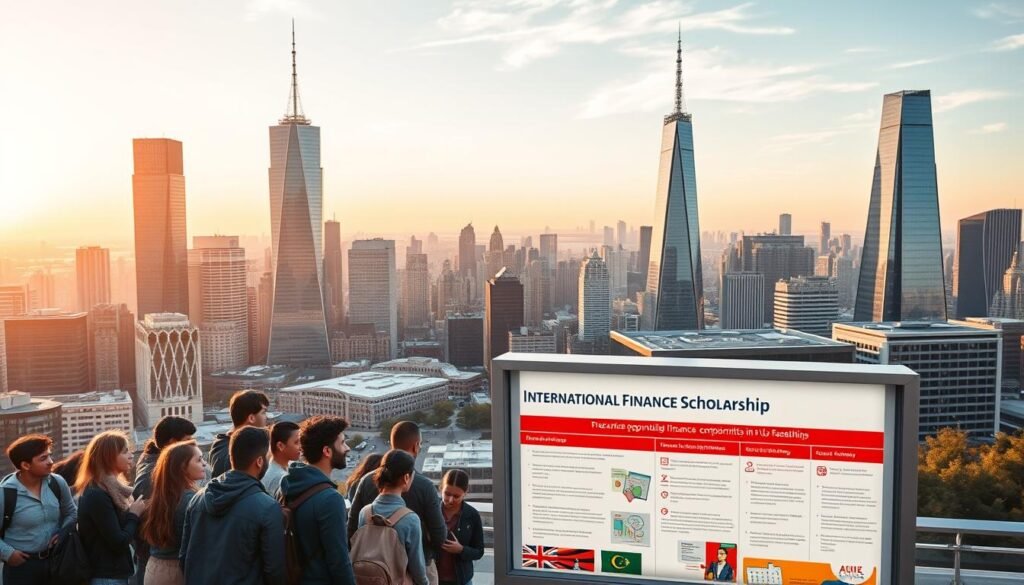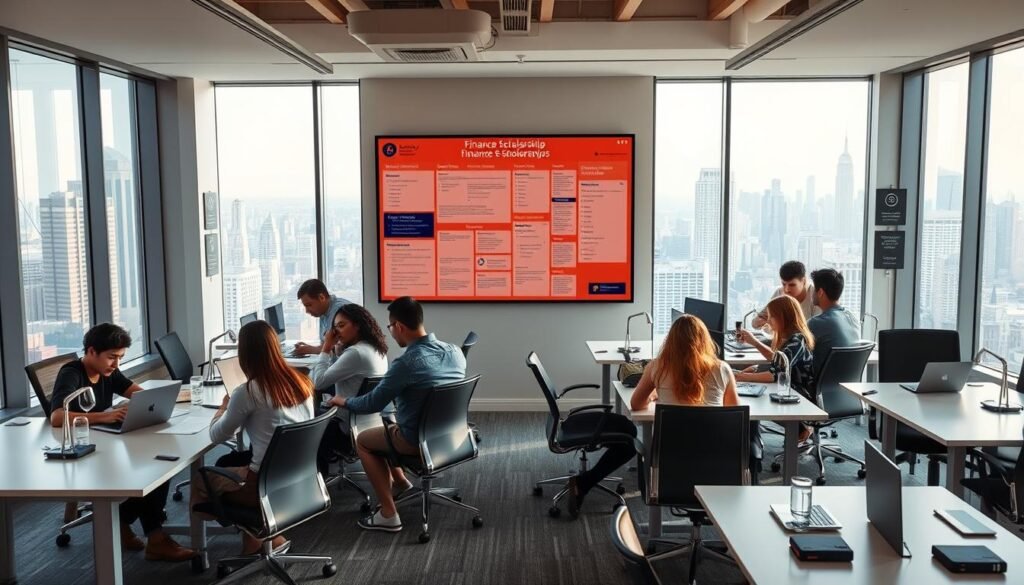
International Finance Scholarships USA: Funding Your Future

You want a clear path to fund your studies in the United States. Imagine a young international student who found a small essay prompt and turned it into a full tuition award. That first win eased bills and gave room to plan.
The story matters because funding often starts with one simple step: a well-crafted application. You’ll learn where to look first, how programs like MPOWER work, and what selection committees value: clear goals, alignment with your field, and strong communication.
Use this guide as your hub for scholarships, backup financing, and practical deadlines. You’ll see trusted databases like, IEFA, and advice to check your college financial aid office. By the end, you’ll have a friendly plan to keep your education on track and move your dreams forward.
- Start here: your resource hub for international finance scholarships USA
- Understanding eligibility and criteria before you apply
- Where to find scholarships and awards you can actually use
- Spotlight: MPOWER open scholarships, deadlines, and award amounts
- international finance scholarships USA: application strategies that win
- Plan ahead: deadlines, admissions, visas, and the year ahead
- Protect your budget: avoiding scholarship scams
- Beyond scholarships: loans, research roles, and campus opportunities
- Your next steps to fund your education and reach your goals
Start here: your resource hub for international finance scholarships USA
Begin your search with a focused list of resources that save time and point you to the best awards. This short hub shows which sites, offices, and tactics matter most so you can act with confidence.

What you’ll find in this guide
Clear checklists, timelines, and trusted portals to move you from “where do I start?” to a simple plan in minutes.
- How to use your school’s financial aid office and staff to find school-specific awards.
- Which free databases to prioritize, like InternationalScholarships.com and IEFA, and how to filter results.
- Steps to triage searches when you’re balancing classes and deadlines.
Who this hub is for
This guide is for students at every stage: admitted, mid-degree, or planning a transfer or graduate program. You’ll get practical tips, triage methods, and a path to high-fit opportunities.
| Resource | What it offers | Best use |
|---|---|---|
| School financial aid office | Institution-specific awards and advisor help | Start here for targeted opportunities |
| InternationalScholarships.com | Large free database of awards | Broad searches and niche filters |
| IEFA | Scholarship search, featured schools, state guides | Find programs actively seeking students |
| Study Finance hub | Guides and next-step checklists | about us for support and planning |
Understanding eligibility and criteria before you apply
A quick eligibility check saves hours and keeps your applications focused. Start by reading each award's rules so you can decide whether to invest time in an application.

Common eligibility criteria across awards
Basic factors usually include full-time enrollment in a qualifying degree program, authorization to study, and attendance at a listed school.
Some programs require a stamped visa for study in the U.S. by the closing date. Others accept conditional admission; read the fine print so you know if you qualify as an applicant.
Program enrollment, visa status, and school requirements
Confirm your school appears on the sponsor’s eligibility list before you apply. Missing that step is a common disqualifier.
Also check whether your degree level (bachelor’s, master’s, or doctoral) matches the award’s criteria. Include proof of status and admission documents with your application.
How winners are evaluated: clarity of goals and field alignment
Many programs judge winners on essays that show clear goals, a strong nexus between field of study and long-term plans, and leadership potential.
For example, MPOWER selects winners solely on essay strength: clarity of thought, superior English communication, and a compelling vision matter most.
- Present research, internships, and volunteer work concisely.
- Avoid missing documents or mismatched degree levels.
- Scan criteria first; if you fit, focus your essay on goals and impact.
For a recent example of targeted support programs, see this medical student award that emphasizes clear goals and community impact.
Where to find scholarships and awards you can actually use
Your best leads often live inside your university not on big public sites. Start at the college financial aid office to find awards that don’t appear in broad searches.

Your college financial aid office and school-specific awards
Read your university funding pages, sign up for departmental newsletters, and email the office contact listed on award pages. Small awards are often posted only on campus portals.
Free databases: InternationalScholarships.com and IEFA
Use InternationalScholarships.com’s free filters to match degree level and field. Then run IEFA’s quick scholarship search to gather featured awards fast.
Featured schools and state guides for study u.s.
IEFA’s featured schools and state guides show which universities and states actively support students. Track rolling awards and monthly series so you can apply all year.
| Source | Best use | Action |
|---|---|---|
| College financial aid office | Campus-only awards | Subscribe, email contact, check portal |
| InternationalScholarships.com | Wide free search | Filter by degree and field |
| IEFA | Featured awards & state guides | Build a shortlist, track rolling deadlines |
| Study Finance hub | Guides and trackers | Use templates to log deadlines and documents |
Quick tip: keep a simple spreadsheet for links, eligibility, deadlines, and follow-ups. That small step helps you stack smaller awards with campus funding and close budget gaps.
Spotlight: MPOWER open scholarships, deadlines, and award amounts
MPOWER offers a predictable rhythm of awards you can plan around each month.
Monthly Scholarship Series: steady $1,000 awards
The Monthly Scholarship Series posts a new theme each month. Deadlines fall on the last day of every month. Three awards of US$1,000 are given to enrolled students at MPOWER-supported schools.
Flagship and regional awards
Major awards share a common deadline of January 31, 2026. Amounts vary:
| Award | Range | Deadline |
|---|---|---|
| Global Citizen | US$1,000–US$8,000 | Jan 31, 2026 |
| Women in STEM | US$1,000–US$5,000 | Jan 31, 2026 |
| MBA | US$1,000–US$5,000 | Jan 31, 2026 |
| Regional (China / India) | US$500–US$5,000 / US$1,000–US$5,000 | Jan 31, 2026 |
Eligibility, timelines, and disbursement
To qualify, an applicant must be accepted or enrolled full-time at an MPOWER-eligible university and be legally permitted to study. You do not need to be an MPOWER borrower to apply.
Winners are notified within eight weeks of the deadline. After verification and a signed Release form, funds are sent directly to your school account.
Selection focus and winners’ stories
Selection depends on a clear essay, strong goals, top communication, and a tight link between your field and degree plans.
"I learned to frame my commitment and community impact clearly." Klaudia Zwonik; Muhammad Miran Shaikh; Shinora Khan; Benard Adewole
- Plan multiple monthly entries and target annual deadlines.
- Checklist: confirm eligibility, draft an essay, attach proof of enrollment, and prepare the application form.
international finance scholarships USA: application strategies that win
Start your application by painting a vivid, specific picture of the future you plan to build. Lead with your goals and then anchor them to concrete coursework, projects, or internships in your field.
Building a standout essay with clear goals and superior communication
Open with a purposeful line that states your goal in one sentence. Follow with two short examples that show past impact and one sentence that links study plans to future outcomes.
Write short, active sentences. Use numbers, roles, and results to show impact. MPOWER and similar programs pick winners based on clarity, vision, and strong English communication.
Completing the application form and aligning your field of study
Keep a digital folder with transcripts, enrollment proof, visa documents, resume, and a 150–250 word bio. Tailor each application to program fit STEM, MBA, or global citizen themes while keeping your authentic voice.
- Outline, write, peer review, refine repeat to improve your learning.
- Build core paragraphs (motivation, field alignment, community impact) for quick tailoring.
- Micro-edits: stronger opening, specific numbers, and a closing that restates goals and impact.
"Clear goals, concrete examples, and direct ties to your field make an essay stand out."
Pre-submit checklist: eligibility confirmed, prompt matched, word limit met, proofread, and all documents uploaded. Submit with confidence and track each application for follow-up.
Plan ahead: deadlines, admissions, visas, and the year ahead
Map your next 12 months to sync admissions decisions, embassy visits, and award deadlines. A short, visual calendar helps you spot conflicts and build realistic buffers.
Sequencing admissions, visa stamping, and scholarship cutoffs
Start with your admissions timeline: acceptances, I-20 or DS-2019 issuance, then book a visa interview. For some awards, you must have your visa stamped by the closing date, so treat embassy appointments as part of the application plan.
Remember: MPOWER and similar monthly awards require a stamped visa at submission for certain categories. Notifications usually arrive within eight weeks of a deadline, so work backward from tuition due dates.
Tracking rolling and monthly deadlines into the future
Create a simple tracking sheet that lists rolling awards, monthly series (last-day deadlines), and fixed annual cutoffs. Update it each month so you catch new postings and avoid last-minute rushes.
- Map tasks in order: admissions → document collection → visa stamping → application submission.
- Plan buffers: time for essays, transcripts, embassy wait times, and the eight-week notification window.
- Stagger applications: submit rolling awards first, then layer monthly and annual deadlines.
Tip: Add school billing and orientation dates to your calendar so funding posts before registration. After each round, log outcomes and refine essays your process will improve each year.
Protect your budget: avoiding scholarship scams
Not every bright offer is real; spotting fake awards keeps your budget safe. Scams often mimic real programs and ask for fees or sensitive data. Stay calm and check before you click.
Red flags and safe-search practices for international students
Classic red flags: upfront fees to access "exclusive" lists, promises of guaranteed winners, or requests for banking details that are unrelated to a legit form.
Use trusted sites: your school’s financial aid pages, InternationalScholarships.com, and IEFA. Cross-check any eligible scholarship on the official sponsor page and read past winners' stories when available.
- Never pay to apply or buy a list. Free, reputable databases exist.
- Redact unneeded IDs, never share bank passwords, and store passport scans securely.
- Avoid essay mills and paid application services they often harm, not help.
"Verify the funder, confirm disbursement to your school, and check for clear contact details."
| Risk | What to check | Safe action |
|---|---|---|
| Upfront fee | Is payment requested to view awards? | Decline and use free databases |
| Guaranteed winners | Are claims vague or pressured? | Search for past winners and contact funder |
| Suspicious form requests | Are banking details or full ID pages required? | Share only school-required info; redact extras |
| No contact or transparency | Is selection criteria missing? | Verify nonprofit/company registration and privacy policy |
Reporting plan: if you see a suspicious offer, alert your financial aid office and campus security. Reporting protects you and others and helps keep real awards available.
Beyond scholarships: loans, research roles, and campus opportunities
When scholarships leave a gap, smart loans and campus roles help you close it without losing momentum.
IEFA partners with leading lenders so you can explore reputable international student loan options to fill shortfalls. Compare interest rates, deferral plans, co-signer rules, and how disbursement aligns with college billing before you sign.
On-campus work that fits your schedule
Look for library, lab, and departmental positions that respect visa rules. These roles offer steady pay and practical experience. Tailor your resume, show reliability, and apply early.
Research assistantships and campus support
Pursue RA posts to gain skills, funding, and publication chances. Stipends or tuition offsets often accompany these roles and boost your resume as an applicant for future awards or jobs.
- Build contacts: career services, international office, and department staff.
- Coordinate funding: loans, campus work, research, and awards so your budget stays stable.
- Track application windows and complete payroll onboarding before term start.
Featured schools on IEFA often list targeted support for international students. For a quick profile of a successful student winner, review campus announcements and model your approach.
Your next steps to fund your education and reach your goals
Set a clear, weekly plan now to turn applications into tangible awards over the coming year.
Pick 5–10 high-fit opportunities this week and schedule monthly checks for rolling and last-day cycles. Draft one core essay you can tailor, and keep transcripts, enrollment proof, visa pages, resume, and the signed form ready to upload.
Submit two monthly applications and target higher-value annual awards on their earlier deadline dates. Confirm eligibility and school requirements first so you only apply to an eligible scholarship for your profile.
Track outcomes, ask mentors for feedback, and engage your community for review. MPOWER winners are notified within eight weeks; after verification and a signed Release Form, funds go straight to your university account.
Use free tools like IEFA and this guide to find undergraduate scholarships: undergraduate scholarships. With steady effort and clear focus, you’ll turn applications into awards and move toward your degree and dreams.
If you want to know other articles similar to International Finance Scholarships USA: Funding Your Future you can visit the category Scholarships.






Leave a Reply